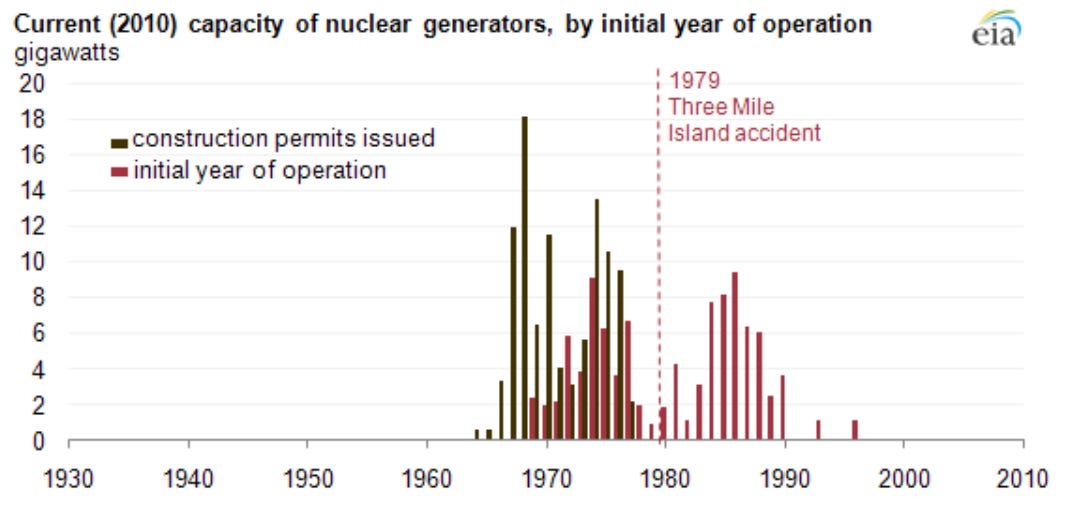A History of Highs and Lows: Will Nuclear Power’s Latest Comeback Stick?
Can the climate-driven revival of nuclear energy finally break the cycle of setbacks? What role will tech companies play?
How the 1979 Three Mile Island Accident Transformed U.S. Nuclear Energy: A Catalyst for Decades of Stagnation
The 1979 accident at Three Mile Island (TMI) had a massive impact on the nuclear industry in the U.S. and globally. Public support for nuclear power sharply declined, with concerns over safety escalating. The accident halted the expansion of new nuclear plants in the U.S., leading to a moratorium on reactor licensing. Additionally, regulations were tightened, including significant improvements in safety systems and emergency preparedness, which have evolved continuously over time. These changes contributed to a steep decline in new plant constructions for decades.
By the time of the TMI accident, the majority of U.S. reactors had already been built. A slowdown in the industry was already underway, spurred in part by a declining growth rate in electricity demand. The TMI accident compounded these pressures, with spiraling construction costs driven by stringent safety assessments and heightened investment risks. Public support dwindled further, and no new reactor permits were issued in the U.S. for years, marking a long hiatus in nuclear development—one that only recently began to shift.
Nuclear Power’s Post-2000 Revival: Climate Imperatives, Technological Advances, and Ongoing Challenges
After 2000, nuclear power experienced a modest revival, driven largely by escalating concerns over climate change and the urgent need for low-carbon energy sources. As the fight against greenhouse gas emissions intensified, policymakers and even some environmental advocates began to reassess nuclear energy's potential as a solution. Its capacity to produce vast amounts of energy without carbon emissions made it an attractive, if contentious, option in the broader climate strategy.
The industry also saw technological advancements that bolstered its case. Innovations like improved reactor safety systems, along with the introduction of Generation 3+ and Generation 4 designs, promised greater safety and reliability. The development of smaller modular reactors (SMRs) further signaled a shift toward more flexible, scalable nuclear solutions. Yet, even with these advances, high construction costs and protracted building timelines continued to cast a shadow over nuclear’s revival, posing formidable challenges to its widespread resurgence.
Fukushima’s Fallout: A Global Reckoning for Nuclear Energy
The Fukushima disaster in 2011 reignited global fears surrounding the safety of nuclear energy, sending shockwaves through the industry. In many nations, the disaster led to either a scaling back of existing nuclear programs or the outright cessation of future developments, as dramatically demonstrated by Germany’s decision to phase out nuclear power entirely. Safety regulations were further tightened worldwide, as countries reevaluated their nuclear strategies with a heightened sense of caution.
However, the global response was far from uniform. While many nations reconsidered their nuclear ambitions, others—most notably China and Russia—pressed forward, expanding their nuclear infrastructure. For these countries, nuclear power remained a cornerstone of energy strategy, driven by the desire for energy security and low-carbon growth.
Nuclear Power’s Critical Role in the Global Energy Transition: Climate Imperatives and the Path to Net-Zero
Nuclear power has recently re-emerged as a critical component of the global energy transition, especially in light of climate imperatives. The Intergovernmental Panel on Climate Change (IPCC) has highlighted the potential for nuclear energy to play a significant role in achieving net-zero carbon goals, recognizing its capacity to provide a reliable, stable power source.
The International Energy Agency’s (IEA) Net Zero Emissions by 2050 Scenario (NZE) envisions a future where emissions decline to zero by 2050, primarily through the expanded use of renewables. However, the IEA also acknowledges that nuclear energy must play a vital role in complementing these efforts (source). Similarly, the IPCC’s 2018 report considered 90 different pathways to limit global warming to below 1.5°C, finding that nuclear capacity would need to expand from 394 GW in 2020 to 1,160 GW by 2050 to meet these ambitious climate goals (source). These conclusions are echoed by other recent analyses, underscoring nuclear's essential contribution to a sustainable energy future (source).
As renewable energy adoption accelerates, the need for "firm" electricity—dispatchable power that remains available regardless of conditions—is becoming increasingly apparent. Various energy models suggest that firm electricity must account for at least 20% of the power mix to ensure a stable grid (source). Nuclear power, with its consistent output, is well-positioned to fulfill this crucial role, particularly as reliance on variable renewable sources grows.

